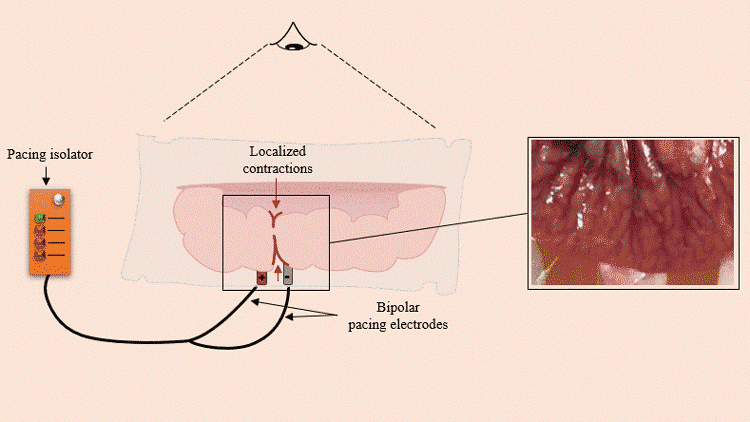Compromised bowel function is associated with a range of motility disorders such as post-operative ileus and chronic intestinal pseudo-obstruction. Disordered or weak motility compromise the efficient movement of luminal contents necessary for digestion and nutrient absorption. This study investigated the potential of high-energy pacing to enhance contractions in the proximal jejunum of the small intestine. Pacing pulse parameters (pulse-width: 100 ms, 200 ms, 400 ms, pulse-amplitude: 4 mA, 6 mA, 8 mA) were systematically varied in the in vivo porcine jejunum (n=7) and the induced contractile responses were evaluated using a video mapping system. Localized segmental contractions were quantified by measuring the intestinal diameter and thereby computing the strain. The impact of pacing parameters on contractile strain was investigated. Finally, histological studies were conducted on paced tissue to assess for potential tissue damage. Segmental contractions were successfully induced at all pulse-settings and evaluated across 67 pacing sessions. In response to pacing, the intestine segment at the site of pacing contracted, with diameter reduced by 6-18%. While contractile response increased with increasing pulse-amplitude, there was no significant increase in contractions beyond 6 mA. While the contractile response was enhanced with increasing pulse-width, the increase was significant only between 100 ms and 400 ms. Histology showed no tissue damage occurred when maximal pacing energy (pulse-amplitude=4-8 mA, pulse-width=400 ms, 5 minute duration) was applied. High-energy pacing induced periodic segmental contractions in response to pacing pulses and the contractile strain was proportional to the energy applied on the intestine. The ability to enhance motility through pacing may hold promising therapeutic potential for bowel disorders and awaits clinical translation. Small intestine pacing elicits localized segmental contractions which increase in magnitude with increasing pulse settings. This study marks the first application of video mapping techniques to track the pacing response in the small intestine.

High-energy pacing in the jejunum elicits pulsatile segmental contractions
Sign-in or become an IEEE member to discover the full contents of the paper.
